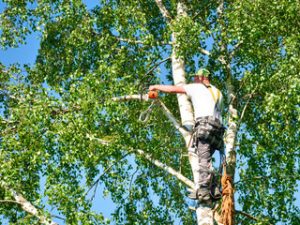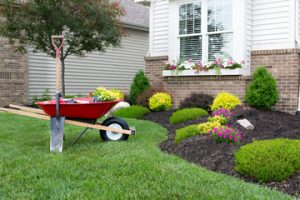Trees are a beautiful part of the landscape, but they do require care. Sometimes it is best to prune them instead of removing them altogether.

But sometimes a tree needs to be removed due to safety concerns or damage. When this happens it is important to use a professional service to ensure that the work is done safely and effectively.
Pruning is the process of trimming trees, shrubs, and hedges to improve their appearance, reduce hazards, promote growth, and enhance property values. It involves removing dead or diseased limbs, maintaining clearance for pedestrians and vehicles, promoting good air circulation, controlling the flow of water, and increasing light penetration. Pruning also helps prevent the spread of diseases, pests, and fungi to other plants.
Proper pruning helps your trees and shrubs stay healthy and strong. It increases sunlight and airflow to the lower canopy, which stimulates branching and improves flower and fruit production. It also reduces risk of damage from storms, winds, and insects by removing weakened or damaged limbs. Pruning can also be used to shape a tree or create an open, symmetrical design that is pleasing to the eye.
In addition to removing unhealthy limbs, regular pruning can help trees and shrubs retain their structural integrity by reducing the weight of oversized limbs. This can be especially important for trees that are growing near homes, utility lines, or other structures, as a heavy limb that is damaged during a storm may cause damage or even fall on a house, car, or person.
Pruning can also be used to train young trees and promote good form. By removing unnecessary limbs during the first few years of growth, arborists can shape trees to their desired form without cutting back the leader or damaging the structure of the crown. This training also helps eliminate crossing branches, which can weaken a tree, and encourages healthy, upright growth.
Safety and structure are the most important reasons for regular pruning. Weak or damaged limbs are more likely to break during a storm, creating hazardous conditions for people and cars. In addition, a tree that is overgrown can pose problems with power lines, and limbs that hang over buildings or homes can damage roofs or gutters.
In some cases, a tree or shrub might need to be removed completely. This might be a result of extensive structural damage, an insect infestation, or a severe tree disease. In these situations, it is usually best to remove the entire tree rather than trying to save a small portion of it.
Removal
Trees add beauty and value to landscapes but may also pose risks if they become damaged, overgrown or dead. They can fall during storms or high winds and cause property damage, injury, or death to people and animals. The removal of hazardous trees can reduce the risks posed to those on or near the property and prevent injuries, deaths, and damage to buildings, vehicles, or structures.
There are a number of reasons that a tree may need to be removed, including poor location or maturity. Mature trees can drop large limbs, which may interfere with traffic or power lines, and are more likely to be struck by lightning. In addition, mature trees are more likely to suffer from branch failure and may be more vulnerable to insect infestation and disease.
Removing damaged, dying or dead trees can help promote overall landscape health and vigor by removing competition for resources such as sunlight, water, and nutrients. It can also protect against diseases and pests that threaten the health and safety of surrounding vegetation.
When considering tree removal, it is important to consult with a trained professional. They can assess the situation, recommend alternative options and help weigh the risks and benefits of removal. Additionally, hiring a reputable service will ensure that the process is done safely and correctly to avoid injury and property damage. Properly executed tree removal can also help to mitigate environmental impact by reducing soil erosion and protecting adjacent water bodies.
Safety
When performing a tree removal, proper safety measures must be taken. This includes wearing personal protective equipment, securing the work area to keep bystanders at a safe distance, and assessing the potential fall trajectory of the tree. It is also important to ensure that all power lines are disconnected before starting work. Arborists and other tree professionals understand the importance of following these safety rules, not only for their own safety but also to protect property owners and pedestrians.
In some cases, a tree must be removed because it poses a serious risk to people or property. For example, if a tree is leaning or in disrepair, it may be at risk of falling over in a storm. It is also possible for a tree to become unstable due to damage or disease. In such situations, it is recommended to call for professional tree removal services.
While the decision to remove a tree isn’t always easy, it can be the best option for long-term health and safety. A qualified arborist can help you determine whether a particular tree is at risk and can offer solutions such as pruning, cabling, or bracing to reduce the risk.
One of the most common reasons to remove a tree is that it has been damaged or diseased beyond repair. For example, a tree that has been injured by vehicle or construction traffic can lose stability and potentially fall. Another cause of damage is excess rainfall. This can saturate the soil, weaken the roots, and lead to root rot.
Similarly, a tree that has become infected with fungus should be removed. However, not all fungi are harmful and some actually play a role in a tree’s ecosystem. A certified arborist can tell you what type of fungi is growing on a tree and if it poses a threat to the health or structure of the plant. If the fungus is a danger to people or property, it should be removed immediately. In addition, a damaged or dead stump is unsightly and an accident waiting to happen. A professional stump grinder can be used to grind a tree’s remaining roots to remove the stump and create a smooth surface for landscaping.
Insurance
Homeowners insurance typically covers the cost of tree removal if it’s needed to protect your property. For example, if a tree is dying or leaning and threatens to fall, you can file a homeowners claim to have it removed before the problem escalates into something more serious. Additionally, if a tree falls due to a covered peril such as a storm or lightning, your homeowners insurance may cover the cost of repairs to your house and other structures on your property like a shed or fence.
Preventative tree removal is not usually covered by homeowners insurance, however. Having your property regularly inspected and dead or diseased trees removed can help reduce the risk of damage to your property or injuries to those on your premises. This can save you the expense of a claim and may also prevent expensive repairs or replacements in the future.
In some cases, your homeowner’s insurance policy may even provide financial assistance if your neighbors’ trees fall and cause damage to your home. However, this type of coverage is only available if both parties have a good relationship and clear communication with each other and their insurance companies. Additionally, you must have comprehensive – sometimes called “other-than-collision” – coverage on your policy to be eligible for this benefit.
Upgrading your safety measures and investing in a solid tree service insurance plan not only helps your business stay protected from claims and lawsuits, but it also shows insurers that you are a low-risk customer. This can result in lower premiums and a more competitive insurance market for you. Clients notice when your limits are high and your certificates of insurance are fast to produce, indicating that you take your job seriously. This can make the difference in winning commercial bids and proposals. It also eliminates the risk of out-of-pocket expenses that can stall your growth or ruin trust with clients. To get the right coverage for your tree service company, talk to an experienced insurance agent today. They’ll be able to recommend a policy that fits your needs and budget.

